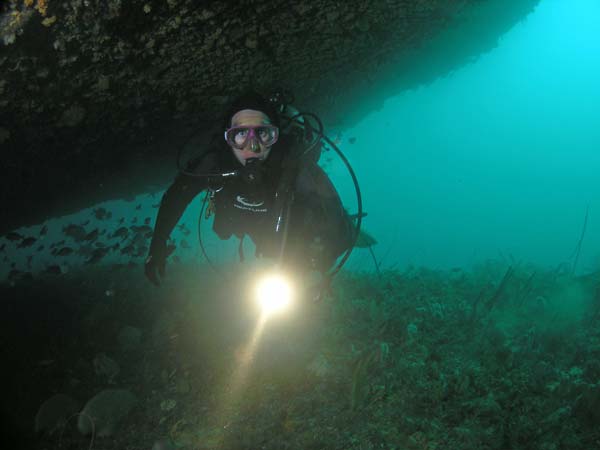|
The diving at Bicheno in Tasmania is concentrated around Governors Island which lies only 20 or so metres off the mainland. The area surrounding the island, at least on the open ocean side, is a marine reserve. As such, the reef and the fishlife is far more prolific than outside the reserve.
The ocean bottom drops off dramatically on the northern side of the island and there are numerous underwater features like caves, canyons and bommies that make this location even more interesting. Due to the depth on the sand (almost 40 metres in some spots) which limits your bottom time, there are literally dozens of different dive sites that can be explored. One of these is Castle Cave.
 |  |
| Kelly in the overhang to the east of the cave | Kelly entering the cave from the west |
Castle Cave is located on the same section of reef as The Canyon, but to the south. In fact, some of the dive explores a similar section of reef, especially the last bit as you ascend into shallower water. However, it is in reality a different dive as you could not safely explore the more interesting sections on the one dive.
The GPS Reading for this site is 41Âș 52' 14.1"S 148Âș 19' 02.1"E. it only takes about three minutes to get here from the boat ramp. As with all dives here, the dive operator drops you over the site and you free ascend at the end of the dive. This will put you over the top of the wall to the east of the main cave and in about 15 or so metres of water.
Once in the water, you descend to the top of the reef and then head south and drop over the wall. This goes down vertically to about 26 metres. In this area there is a large but low overhang. This can be entered and there is normally a lot of fish inside, including large bastard trumpeters. There are also many crayfish and abalone in the corners. The overhang is about 30 metres long and one to two metres high, depending on where you are. Examine this and if you are a photographer, you will get some nice photos looking out.
 |  |
Kelly with some of the colourful
marine life near the cave | Kelly in another overhang at 27B |
After you have finished here, head west along the wall and within a short time you will see a large crack or indentation that goes back into the wall. This leads to the start of Castle Cave. If you have swum along inside the overhang, you will have come out right in the indent.
The cave (in reality, it is a tunnel) starts at the back left of the indent. At first, it does not look like it is a tunnel but a low overhang or small cave. However, once you enter it and go about five metres you will see light at the far end of the tunnel. Along this section of the tunnel you will see lots of crayfish. There are some huge ones here as well. There are also lots of abalone.
An alternative to the tunnel is to continue on the outside of the wall. I saw one of the largest crayfish I have ever seen along here in a very low overhang. The walls here and at the start have lots of sea whips, some sponges and some small gorgonias.
The tunnel is perhaps 30 metres long. It comes out in a inverted L shaped indent about 40 metres along the wall (if you travel outside the tunnel). Ahead of you there is another wall that goes from 24 metres way up to 12 metres or so. If you continue along this wall it gradually turns to the north. Along here there are a number of large boulders that lie to the west of the main reef section and which form some cracks and even swim-throughs. This is the same section of reef that you may get to at the end of The Canyon dive.
 |  |
| Kelly in one of the cracks at the back of the dive site | Kelly in a swim-through |
After a couple of these cracks/swim-throughs, you will be probably low on bottom time and need to start your ascent. At the end of one of the cracks there is a crack that heads up to the right (east) and this leads to the top of the reef. Start up the crack and you will see that there is a lot of kelp on both sides and in the crack.
You will soon be in 18 metres and if you start circling the reef in a clockwise direction, you can gradually rise to eight metres and then to five metres. The five metre "peak" is known as Mount Everest and can only be approached in calmer seas.
Even though the entire top of the reef is covered with kelp, this can be interesting. Have a look on the kelp and you may see the small yellow sea spiders that live in and on the kelp. These sometimes have black bands in their legs. In addition, you can get some really nice photos of the kelp, especially the very thick board kelp, as it sways in the surge.
After the dive, you swim out away from Mount Everest to the east and get collected by the dive boat.
You will get about a maximum of 25 minutes on the deeper section of this site, and about 40 minutes all up with safety stop. Visibility here is normally good, at least 15 metres and can get a lot better. The water temperature in March when I dive here was about 16ÂșC.
A really good dive site.
| 
 v6.00.307 © 2003-2005
v6.00.307 © 2003-2005